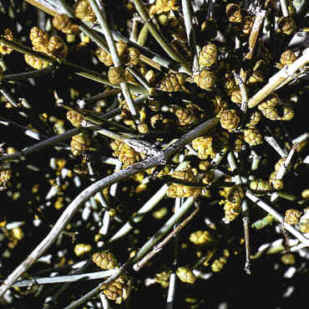
Plant Description
Caution & Interaction

Latin (botanical) name:
Ephedra Sinica
Common names: Ma Huang, Mormon Tea, Squaw Tea, Brigham Tea, American Ephedra, Nevada Joint-Fir, American Ma Huang, Mexican Tea, Desert Ephedra, Desert Tea
Plant Description: Ephedra originates in West Central China, Southern Siberia, and Japan. Varieties of the herb are also grown in Europe, India, Australia and Afghanistan. American Ephedra, native to the dry southwest, was used as tea by the early settlers, and was known as "Mormon tea" and "Squaw tea." It is generally found on sandy seashores and in temperate climates. The Ephedra plant has a pine-like odor and is also known as the "Joint Fir" or "Joint Pine". It is a perennial evergreen that reaches a height of four feet. Nearly leafless, the plant has cylindrical, slender yellow-green branches and under-runners. Some of the flowers bear poisonous, fleshy red cones resembling berries. Only the young stems and branchlets are used in medicinal preparations.
Medicinal Properties &Uses: Ephedra Sinica, or Ma Huang, is a 5000 year old Chinese medicine. It is used primarily as medicine against asthma, allergies and hay fever. Ephedra contains two alkaloids: ephedrine and pseudoephedrine. Ephedrine, the main constituent, is a bronchodilator and stimulates the sympathetic nervous system. As such, it acts promptly in relieving swellings of the mucous membrane. Physicians use these alkaloids and antispasmodic properties to treat bronchial asthma, bronchitis, emphysema, persistent coughs, wheezing, hay fever, and shortness of breath. Ephedra helps the body to break fevers and clear blocked sinuses. The alkaloids are also effective in treating allergic skin reactions such as hives, relieving general body pain, and treating low blood pressure, rheumatism, and narcolepsy. Because of its stimulating effect on the nervous system, Ephedra can now be found in many popular weight loss and energy products. When used to lose weight, it suppresses the appetite and stimulates the thyroid gland which stimulates metabolism.
Dosage: 10-30 drops in water or juice, 2-3 times daily, or as needed. Shake well before using.
Cautions & Interactions: Do not take during pregnancy or while nursing. Keep out of reach of children.
Efficacy Studies & Other Clinical Data: Helpful Links:
Disclaimer (U.S. Only): These statements have not been evaluated by the FDA. These products are not intended to diagnose, cure, treat, or prevent any disease.
Common names: Ma Huang, Mormon Tea, Squaw Tea, Brigham Tea, American Ephedra, Nevada Joint-Fir, American Ma Huang, Mexican Tea, Desert Ephedra, Desert Tea
Plant Description: Ephedra originates in West Central China, Southern Siberia, and Japan. Varieties of the herb are also grown in Europe, India, Australia and Afghanistan. American Ephedra, native to the dry southwest, was used as tea by the early settlers, and was known as "Mormon tea" and "Squaw tea." It is generally found on sandy seashores and in temperate climates. The Ephedra plant has a pine-like odor and is also known as the "Joint Fir" or "Joint Pine". It is a perennial evergreen that reaches a height of four feet. Nearly leafless, the plant has cylindrical, slender yellow-green branches and under-runners. Some of the flowers bear poisonous, fleshy red cones resembling berries. Only the young stems and branchlets are used in medicinal preparations.
Medicinal Properties &Uses: Ephedra Sinica, or Ma Huang, is a 5000 year old Chinese medicine. It is used primarily as medicine against asthma, allergies and hay fever. Ephedra contains two alkaloids: ephedrine and pseudoephedrine. Ephedrine, the main constituent, is a bronchodilator and stimulates the sympathetic nervous system. As such, it acts promptly in relieving swellings of the mucous membrane. Physicians use these alkaloids and antispasmodic properties to treat bronchial asthma, bronchitis, emphysema, persistent coughs, wheezing, hay fever, and shortness of breath. Ephedra helps the body to break fevers and clear blocked sinuses. The alkaloids are also effective in treating allergic skin reactions such as hives, relieving general body pain, and treating low blood pressure, rheumatism, and narcolepsy. Because of its stimulating effect on the nervous system, Ephedra can now be found in many popular weight loss and energy products. When used to lose weight, it suppresses the appetite and stimulates the thyroid gland which stimulates metabolism.
Dosage: 10-30 drops in water or juice, 2-3 times daily, or as needed. Shake well before using.
Cautions & Interactions: Do not take during pregnancy or while nursing. Keep out of reach of children.
Efficacy Studies & Other Clinical Data: Helpful Links:
Disclaimer (U.S. Only): These statements have not been evaluated by the FDA. These products are not intended to diagnose, cure, treat, or prevent any disease.